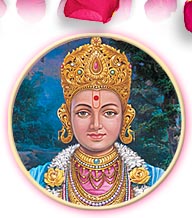|
Philosophy:
Bhagwan Swaminarayan's philosophy, known as Navya Vishishtadvaita (Neo-qualified
non-dualism), upholds the existence of the five eternal realities,
namely: Jiva, Ishwar, Maya, Brahman and Parabrahman.1
Jiva (Soul) is sentient (chaitanya), subtle and is the knower
(jnata) and enjoyer (bhokta) of things. He is immutable, unpierceable,
indivisible and eternal. Jivas are infinite in number and bound
by vasana (impressions and desires from past births and present
birth) according to their karmas.
Ishwars transcend Jiva. Each Ishwar is a conscious spiritual being,
possessing excellence involved in the creation, sustenance and
destruction of the universe. They also are infinite in number
and bound by Maya. Parabrahman is the inner Ruler and Controller
(antaryamin) of both Jiva and Ishwar. Just as the gross, subtle
and causal are the three bodies of Jiva, similarly, Virat, Sutratma
and Avyakrut are the three bodies of Ishwar.
Maya or Prakruti is trigunatmika - consisting of the three gunas
- sattva, rajas and tamas. Its nature is of ignorance and darkness,
and is also the instrument - shakti of Parabrahman. It is non-sentient
primordial matter out of which the whole universe is evolved.
Difficult to transcend, it is the cause of attachment of the Jivas
and Ishwars to their bodies and bodily relations.
Brahman, also known as Akshar, is the highest eternal reality
beyond which stands only Purushottam or Parabrahman. Akshar as
- personal (sakar) is the choicest devotee, eternally in the service
of Lord Purushottam, in the highest abode.
This same Akshar, also serves Lord Purushottam as His infinitely
effulgent abode (Dham), wherein Lord Purushottam and innumerable
released souls reside.
It is the same Akshar who, as infinite, homogeneous, all-pervading,
sentient - space (Chidakash) pervades within and without an infinite
number of universes and every element thereof. And, it is the
same Akshar, who in the form of the Param Ekantik Sadhu, perennially
manifests on earth to redeem the seekers of moksha. Akshar is
also the medium who embodies Lord Purushottam fully in his person.
Parabrahman or Purushottam, is the Supreme Reality. He possesses
an infinite number of kalyankari (redemptive) attributes. He transcends
Jiva, Ishwar, Maya and Brahman, and is immanent in them, they
being absolutely dependent on Him. He is the cause, controller,
sustainer, redeemer, the support of all and dispenser of the fruits
of all karmas. He alone is independent.
He is also the indwelling spirit, antaryamin, of the other four
realities. He is eternally full of divine bliss and has eternally
a divine form, shaped like a human being. Nothing transcends Parabrahman.
He is the goal for meditational worship - of upasana, by all,
including Aksharbrahman. He is one and unparalleled and is commonly
known as Paramatma, Param-Purush, Parameshwar, Purna Purushottam
and Narayan.
Concept
of Moksha
Bhagwan Swaminarayan elaborates moksha or final emancipation, known
as Atyantik Mukti in the Sampradaya, in the following manner :
Jiva is bound by avidya-karma (Maya). This is ignorance, a delusion
of the Jiva. Therefore, in order to be rid of this ignorance,
the Jiva has to develop Atmanishtha - the knowledge that he is
not the body, but Atma.
But to transcend Maya, this type of mere (samanya) Atmanishtha
is not enough. A higher (vishesh) Atmanishtha needs to be realised
- in which the Atma identifies itself with Aksharbrahman to become
Akshar-rup - like Akshar. This is known as true Jnan and true
Atmanishtha.
The liberated soul, Akshar mukta, then becomes eligible to worship
Parabrahman - the Lord Purushottam, in Akshardham2.
This is in consonance with the Taittiriya Upanishad:3
Brahmavid apnoti Param.
i.e. One who knows Brahman attains Parabrahman.
'Attaining' Parabrahman does not mean merging in Him, as water
merges with water, or light into light. The servitor - Master
relationship - Swami-sevak bhava, always prevails.4
The individuality of the sevak - the mukta always remains.
To become Akshar-rup, the Jiva has to associate with the Satpurush
who is the manifest form of Aksharbrahman, the living embodiment
of Ekantik Dharma, known also as Bhagawata Dharma in the Shrimad
Bhagwatam. Only then does the gateway of moksha open for the Jiva
when he associates with the Satpurush.5
In the Swaminarayan Sampradaya, its founder, Bhagwan Swaminarayan
is worshipped as Parabrahman (Purushottam), the Supreme Reality,
while Gunatitanand Swami, His ideal Bhakta, is worshipped as Aksharbrahman.
Aksharbrahman occupies the same place which Shri Laxmi and Radha
occupy in the Vaishnav schools of Vedanta. Therefore in spite
of being a form of pure Vaishnavism, it is popularly known as
Akshar Purushottam Swaminarayan Sampradaya, and its philosophy
is best described as Neo-Vishishtadvaita.
After incarnating on earth, Parabrahman Bhagwan Swaminarayan, manifests
continuously through the Gunatit Guru, the Param Ekantik Sadhu,
the living embodiment of Aksharbrahman. Today, His Divine Holiness
Pramukh Swami Maharaj, is the current manifest form of Aksharbrahman.
Source References
Dave, H.T. Life & Philosophy of
Shree Swaminarayan. London: George Allen & Unwin,
1974, pp. 49-59.
Dave, Ramesh. M. Life & Work of Shree Swaminarayan. Bombay:
Shastri
Narayanswarupdas, 1966, p.66.
1 Vachanamritam, op.cit., Gadhada I-7, III-10.
2 Vachanamritam, op.cit., Loya 12.
3 Taittiriya Upanishad 2-1.
4 Vachanamritam, op.cit., Gadhada II-38.
5 ibid., Gadhada I-54, Shrimad Bhagwatam 3/29/20.
|









